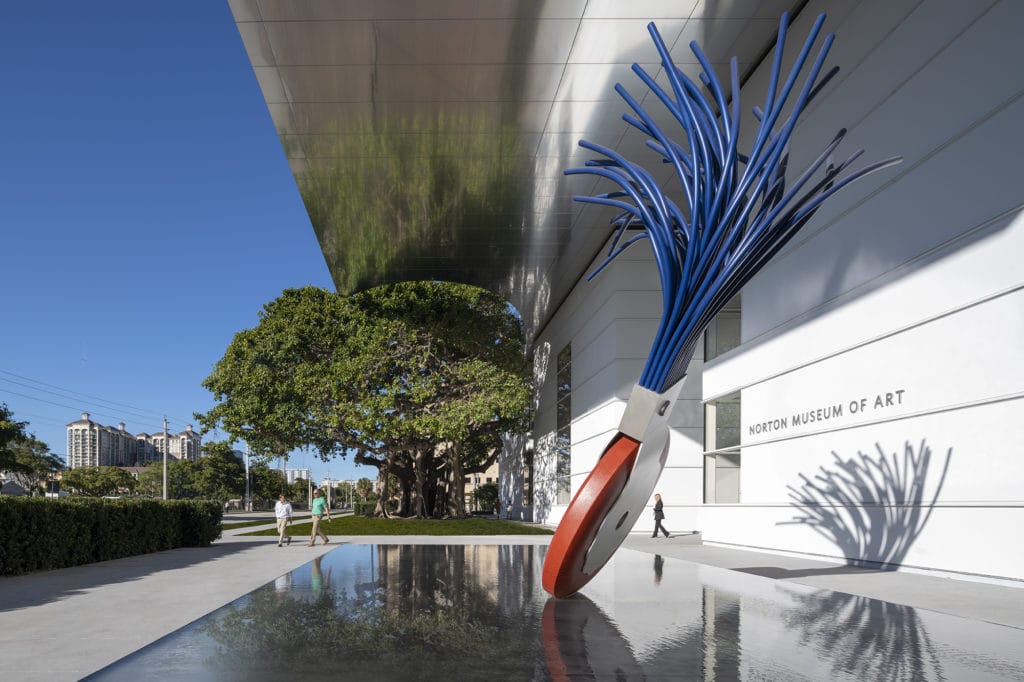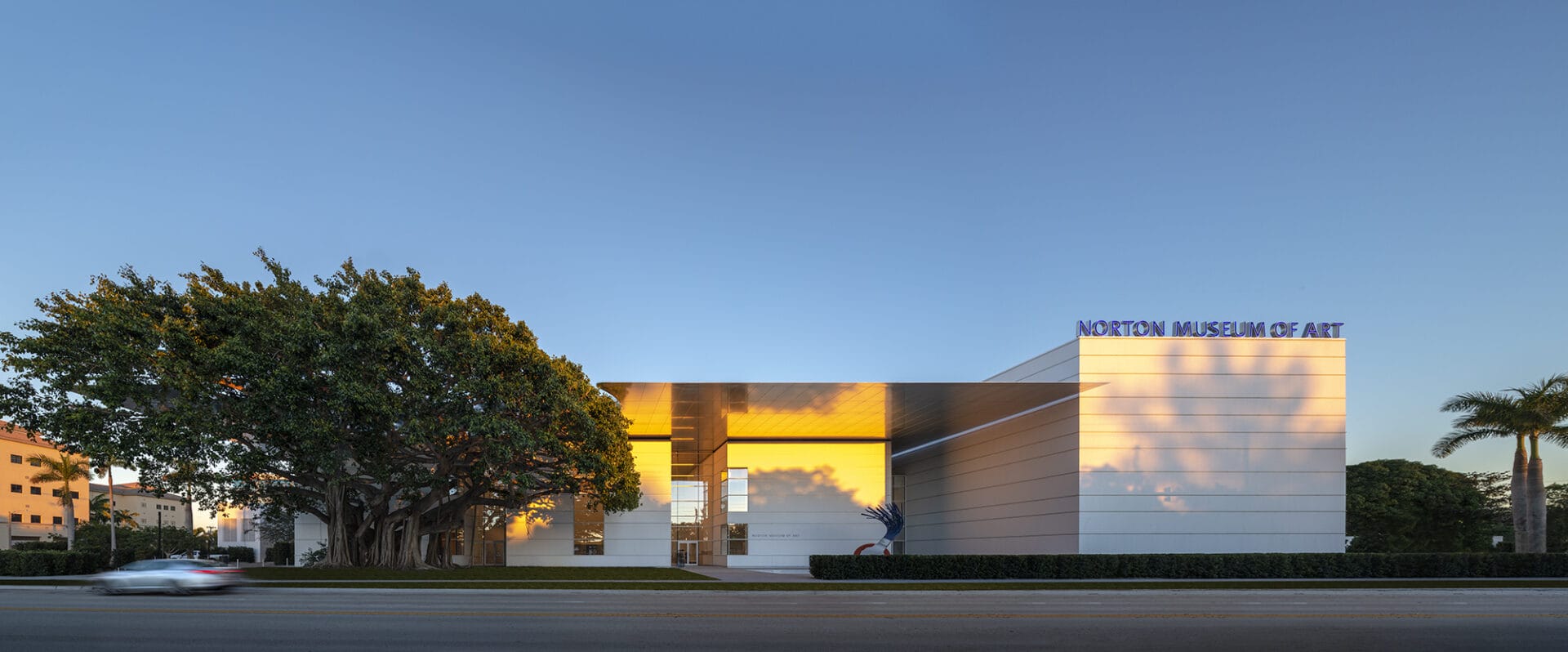By Tom Austin
Photography courtesy of the Norton Museum of Art
Art is light. In the Norton Museum of Art’s Great Hall, sunlight filters through a banyan tree that sits just outside a 10-foot-wide and 30-foot-tall window and trickles down from an 18-foot-wide oculus in the ceiling. The sunlight bathes artist Pae White’s Eikon, a large hanging textile piece, in luminescence. “I love how Eikon looks with all this light; this is such a spectacular space,” White says.
The 3,600-square-foot Great Hall, formally called the Ruth and Carl Shapiro Great Hall, serves as the museum’s aesthetic engine, a place where visitors can talk, read and mull over the big picture. The new space is a product of the Norton’s $100 million, yearslong renovation and expansion, which debuted in February. The project was led by Hope Alswang, who served as executive director and CEO of the Norton from 2010 until this March, and Lord Norman Foster, founder of Foster and Partners, a worldwide architectural practice that opened in London in 1967.
Foster is a man of many worlds, responsible for London’s futuristic Gherkin tower and the British Museum’s Great Court. His architectural vision for the Norton is intended to guide a city balanced between the past and the pure possibility of the future. “Architecturally, it’s important to be distinguished from the herd, and here, we’ve incorporated a banyan tree in the design,” says Foster, who won the Pritzker Architecture Prize in 1999. “This was the right time for a new Norton. West Palm Beach—and South Florida itself—has a more positive mood now.”

Foster’s Norton is a declaration of ambition for West Palm Beach. Accessible from South Dixie Highway, the new west-facing entrance is defined by a shimmering 43-foot-high and 45-foot-wide aluminum canopy, which partly wraps around the 65-foot-tall banyan tree. Nearby in a shallow reflecting pool is the 19-foot-tall Claes Oldenburg and Coosje van Bruggen sculpture Typewriter Eraser, Scale X. There’s also a touch of flash to the building’s façade, with the name of the museum spelled out in blue LED lights on top of the roof. “As cars whiz by, the LED sign—and Oldenburg and van Bruggen’s sculpture—becomes a marquee presence, a clear announcement of the business this building is in,” Foster says. “On another level, the entrance is a kind of embrace for pedestrians. Our aluminum canopy protects visitors from the sun and the rain, and through the glass, you can see the art inside the museum, which lures you in. Every part of the entrance is meant to look as inevitable and as natural as the banyan tree.”
The Norton’s original 1941 Marion Sims Wyeth building, commissioned by museum founders Elizabeth and Ralph Norton, faced east and remains a series of charming art deco-inspired pavilions surrounding a central courtyard. The main Norton entrance was reoriented to the south, next to a small parking lot, in 1997. The lush garden now occupies the space, outfitted with gumbo-limbo trees and sculptures by artists like Keith Haring, and is a vital part of the Norton’s transformation.
“The old Norton was closed off to the natural world,” Foster says. “Nature engages all the senses and can be such an important part of the museum experience.” The garden is also adjacent to an outdoor dining terrace for The Restaurant at the Norton, whose interior features video art by Gregory Scott, known for his pointed films that incorporate paintings and photographs.
The dining space is just one of the many ways the Norton now showcases its art. With 35 percent more exhibition space, more of the Norton’s private collection—made up of more than 7,600 pieces, including works by Pablo Picasso and Georgia O’Keeffe—is seeing the light of day. According to Cheryl Brutvan, the Norton’s director of curatorial affairs, the new exhibition areas provide welcome breathing room. “To have the space for eight opening shows is such a wonderful thing,” she says. “For starters, the exhibition ‘Modern Spontaneity: Ralph Norton’s Watercolor Collection’ gives us a chance to feature beautiful watercolors from our founding collection.”
Additional gallery space allows for interesting juxtapositions. Jenny Saville’s 2012 piece Mnemosyne I, an ironic update of the Madonna and child composition, hangs inside the permanent galleries for the Norton’s European art collection, which spans 1300 to 1945. Mnemosyne I is near several other Madonna and child paintings from the 1600s and 1700s. “The European masters idealized children’s faces, but the model for both infants in Mnemosyne is actually my son, a very real contemporary boy,” Saville says.
Design is destiny, and a lot of hope is riding on the museum’s expansion. Shortly before the Norton’s opening in the early 1940s, Palm Beach County had about 80,000 residents; now, the county has a population of nearly 1.5 million, and its appetite for art has grown. The renovation and expansion process, which began when Alswang first met Foster and Partners in 2010, is complete, but in many ways the process is also just beginning, with new director and CEO Elliot Bostwick Davis (formerly with the Museum of Fine Arts, Boston) shepherding the museum’s progress.
For Foster, it’s all about staying bold. “This is a museum with muscles,” he says, “built to lead West Palm Beach into the future.”
ART AT THE NORTON
The Norton’s opening exhibitions span the gamut of art history, including “Good Fortune to All: A Chinese Lantern Festival in 16th-Century Nanjing,” drawn from the Norton’s collection of more than 400 works of Chinese art, on display through June 4. “Spotlight: Ralston Crawford Across Media” combines Crawford’s modernist paintings of the 1940s and 1950s with his photography and is available for viewing until May 14.
The Norton owns more than 4,500 photographs and now has a gallery just for photography shows. On display until November 26, “WHO? A Brief History of Photography through Portraiture” features such luminaries as photographer Lewis Hine. “Out of the Box: Camera-less Photography” encompasses pieces made by the photogram process, exposing gelatin silver print paper in the sun. The exhibition winds up on June 18.
“Oldenburg and van Bruggen: The Typewriter Eraser, a Favored Form” is an exhibition of drawings and studies by one of pop art’s founders, Claes Oldenburg, and his wife, Coosje van Bruggen, responsible for the sculpture Typewriter Eraser, Scale X at the Norton entrance. “Going Public: Florida Collectors Celebrate the Norton” entails some 50 works, borrowed from Florida collectors and including such artists as Nick Cave, Edward Ruscha and Fairfield Porter. Both exhibitions conclude on June 4.
Since 2011, the Norton hosted its annual RAW (Recognition of Art by Women) exhibition, which focuses on a living female painter or sculptor. The latest RAW exhibition is “Nina Chanel Abney: Neon,” a series of colorful paintings examining racism, sexism and other societal injustices, on view through June 25.
This article originally appeared in the Spring 2019 Issue.




